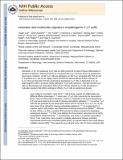Induction and molecular signature of pathogenic T[subscript H]17 cells
Author(s)
Lee, Youjin; Awasthi, Amit; Yosef, Nir; Quintana, Francisco J.; Xiao, Sheng; Peters, Anneli; Wu, Chuan; Kleinewietfeld, Markus; Kunder, Sharon; Hafler, David A.; Sobel, Raymond A.; Regev, Aviv; Kuchroo, Vijay K.; ... Show more Show less
DownloadRegev_Induction and molecular.pdf (2.958Mb)
PUBLISHER_POLICY
Publisher Policy
Article is made available in accordance with the publisher's policy and may be subject to US copyright law. Please refer to the publisher's site for terms of use.
Terms of use
Metadata
Show full item recordAbstract
Interleukin 17 (IL-17)-producing helper T cells (T[subscript H]17 cells) are often present at the sites of tissue inflammation in autoimmune diseases, which has led to the conclusion that T[subscript H]17 cells are main drivers of autoimmune tissue injury. However, not all T[subscript H]17 cells are pathogenic; in fact, T[subscript H]17 cells generated with transforming growth factor-β1 (TGF-β1) and IL-6 produce IL-17 but do not readily induce autoimmune disease without further exposure to IL-23. Here we found that the production of TGF-β3 by developing T[subscript H]17 cells was dependent on IL-23, which together with IL-6 induced very pathogenic T[subscript H]17 cells. Moreover, TGF-β3-induced T[subscript H]17 cells were functionally and molecularly distinct from TGF-β1-induced T[subscript H]17 cells and had a molecular signature that defined pathogenic effector T[subscript H]17 cells in autoimmune disease.
Date issued
2012-09Department
Massachusetts Institute of Technology. Department of BiologyJournal
Nature Immunology
Publisher
Nature Publishing Group
Citation
Lee, Youjin, Amit Awasthi, Nir Yosef, Francisco J Quintana, Sheng Xiao, Anneli Peters, Chuan Wu, et al. “Induction and molecular signature of pathogenic TH17 cells.” Nature Immunology 13, no. 10 (September 9, 2012): 991-999.
Version: Author's final manuscript
ISSN
1529-2908
1529-2916